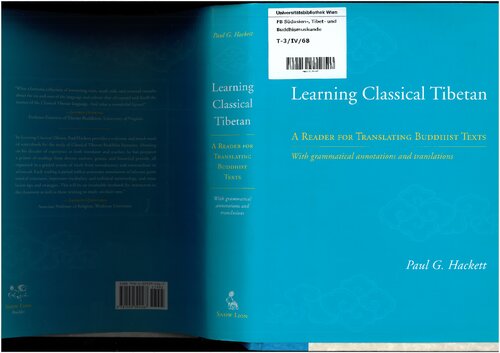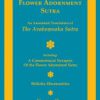Learning Classical Tibetan A Reader for Translating Buddhist Texts 1st Edition by Paul Hackett ISBN 9781559394567 1559394560
$50.00 Original price was: $50.00.$25.00Current price is: $25.00.
Learning Classical Tibetan A Reader for Translating Buddhist Texts 1st Edition by Paul Hackett – Ebook PDF Instant Download/Delivery: 9781559394567 ,1559394560
Full download Learning Classical Tibetan A Reader for Translating Buddhist Texts 1st Edition after payment

Product details:
ISBN 10: 1559394560
ISBN 13: 9781559394567
Author: Paul Hackett
A modern and accessible reader of Classical Tibetan Buddhist texts based on the traditional monastic educational system, designed for both classroom use and independent study
Designed for both classroom use and independent study, Learning Classical Tibetan is a modern and accessible reader for studying traditional Buddhist texts. Unlike other readers of Classical Tibetan, this is a comprehensive manual for navigating Tibetan Buddhist literature drawing on a monastic curriculum. Utilizing the most up-to-date teaching methods and tools for Tibetan language training, students learn to navigate the grammar, vocabulary, syntax, and style of Classical Tibetan while also engaging the content of Buddhist philosophical works.
Chapters consist of a contextual introduction to each reading, a Tibetan text marked with references to annotations that provide progressive explanations of grammar, cultural notes on vocabulary, translation hints, notes on the Sanskrit origins of Tibetan expressions and grammatical structures, as well as a literal translation of the text. The reader also includes study plans for classroom use, discussion of dictionaries and other helpful resources, a glossary of English grammatical and linguistic terms, and much more.
This reader can be used in conjunction with Paul Hackett’s expanded edition of his well-known Tibetan Verb Lexicon. Using a clear and approachable style, Hackett provides a practical and complete manual that will surely benefit all students of Classical Tibetan.
Learning Classical Tibetan A Reader for Translating Buddhist Texts 1st Edition Table of contents:
Chapter 1: Introduction to Classical Tibetan Grammar
1.1 The Tibetan Alphabet and Pronunciation
1.2 Basic Sentence Structure: Subject, Object, Verb
1.3 Word Order and Case Markers
1.4 Verbs: Roots, Prefixes, and Suffixes
1.5 Pronouns and Particles in Tibetan Grammar
1.6 Overview of Tibetan Tense, Aspect, and Mood
1.7 Common Tibetan Grammatical Constructions
Chapter 2: Essential Vocabulary for Buddhist Texts
2.1 Key Terms in Buddhist Philosophy and Practice
2.2 Vocabulary for Meditation, Ethics, and Philosophy
2.3 Common Buddhist Deities, Bodhisattvas, and Concepts
2.4 Terms for Monastic Life and Rituals
2.5 Tibetan Terminology for Scriptures and Commentaries
Chapter 3: Translating Tibetan Sentences
3.1 Simple Sentences and Basic Syntax
3.2 Complex Sentences: Conjunctions and Subordinate Clauses
3.3 Translating from Classical Tibetan to English: Common Challenges
3.4 Word Choices in Translating Buddhist Terminology
3.5 Preserving Meaning and Intent in Translational Practice
3.6 Translating Tibetan Parables and Allegories
Chapter 4: Translating Buddhist Doctrines
4.1 The Four Noble Truths
4.2 Dependent Origination and Emptiness (Śūnyatā)
4.3 The Nature of Mind in Tibetan Buddhist Thought
4.4 Tibetan Interpretations of Buddhist Ethics
4.5 Translating Meditation Instructions and Practices
4.6 Understanding Philosophical Texts and Treatises
Chapter 5: Reading and Translating Tibetan Buddhist Texts
5.1 Introduction to Key Tibetan Buddhist Texts
5.2 Strategies for Approaching Translational Practice
5.3 Reading and Translating Sutras and Tantra
5.4 Working with Commentaries and Scholarly Works
5.5 Understanding Tibetan Buddhist Poetic Forms
Chapter 6: Tibetan Script and Its Role in Translation
6.1 The Evolution of the Tibetan Script
6.2 Translating Handwritten Manuscripts vs. Printed Texts
6.3 Challenges in Decoding Ancient Texts
6.4 Phonetic, Lexical, and Stylistic Variations in Texts
6.5 Practical Tips for Working with Tibetan Scripts
Chapter 7: Translating Tibetan Buddhist Ritual and Liturgical Texts
7.1 Tibetan Buddhist Liturgies: Structure and Vocabulary
7.2 Translating Prayers, Chants, and Rituals
7.3 The Use of Tibetan in Daily Buddhist Practice
7.4 Interpreting Tibetan Buddhist Ceremonial Terms
7.5 Translating Sutra Recitations and Mantras
Chapter 8: Advanced Tibetan Buddhist Translations
8.1 Translating from Classical Tibetan into Modern English
8.2 Addressing Philosophical Nuances in Translation
8.3 Working with Tibetan Buddhist Scholastic Texts
8.4 Translating Tibetan Poetry and Metaphysical Concepts
8.5 The Art of Rewriting and Revising Translations
8.6 Working with Tibetan Buddhist Scholars and Teachers
Chapter 9: Building a Personal Translation Practice
9.1 Developing Your Translation Skills Over Time
9.2 Finding Texts for Translation Practice
9.3 Using Dictionaries, Textual Resources, and Online Tools
9.4 Strategies for Collaborative Translation Projects
9.5 The Ethical Responsibility of Translating Sacred Texts
9.6 How Translation Changes the Meaning of Buddhist Concepts
People also search for Learning Classical Tibetan A Reader for Translating Buddhist Texts 1st Edition:
how to start learning classical guitar
how to start learning classical music
learn classical tibetan online
learning tibetan online
learn tibetan online free
Tags:
Paul Hackett,Learning Classical Tibetan,Translating Buddhist Texts
You may also like…
Romance - Military Romance
Hobbies & Games
The Martial Arts Studies Reader 1st Edition Paul Bowman (Editor)
Business & Economics - Others
Uncategorized
Computers - Artificial Intelligence (AI)
Deep Learning For Dummies 1st editon by John Paul Mueller, Luca Massaron 1119543037 9781119543039
Computers - Artificial Intelligence (AI)
Politics & Philosophy - Ethnography
Handbook of Ethnography in Healthcare Research 1st Edition Paul Hackett Christopher M Hayre Editors












